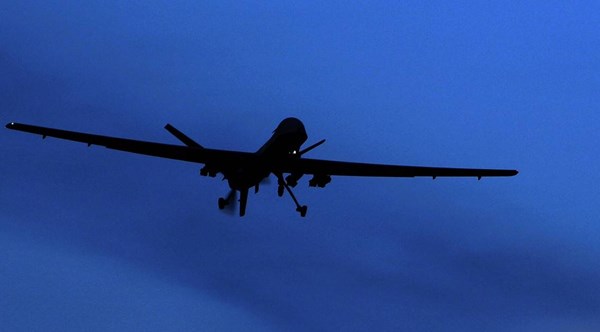Ukraine launches mysterious electronic warfare system designed to combat missiles and drones fired by Russian forces
On January 13, the Ukrainian Air Command South reported that the Ukrainian Armed Forces had shot down 40 aerial threats, including three Shahed drones, with the remaining being various types of missiles. According to the press service, 20 of these threats failed to reach their targets due to electronic warfare (EW). This announcement raised many questions, as there had been no such reports before. In particular, questions arose about how exactly it's possible to influence missiles and why it hadn't been done earlier.
Ukrainian military electronic warfare expert Serhiy Beskrestnov, with the call sign "Flash", revealed that the new Ukrainian Pokrova system was used in countering the air attack. During the national telethon on January 25, Flash reminded viewers that the Commander-in-Chief of the Armed Forces of Ukraine, Valeriy Zaluzhny, had previously mentioned this government program, and it was later mentioned by the Ministry of Defense, although details were kept secret. Serhiy Beskrestnov described Pokrova as a complex of measures and devices aimed at suppressing satellite navigation systems, which is primarily effective against strike drones, but also affects missiles.
"When we talk about EW with respect to cruise missiles and drones, we're referring to a very specialized layer of EW that targets satellite navigation systems — GPS, GLONASS, Beidou. Everyone understands that strike drones, including Shaheds, navigate our territory using satellite navigation. Without satellite signals, a Shahed wouldn't know where to fly. The same is true for cruise missiles," explained the military expert.
For such a system to operate, it must densely cover the entire territory of Ukraine, which requires spreading specialized devices at 30–100km distances and managing them centrally. In the event of an air threat, the EW network is activated across the country or in particular regions to suppress guidance signals. Thus, even if satellite navigation is suppressed, a Russian cruise missile will continue to fly.
The "high art" of EW technology is not just to "blind" but to change the direction or altitude of cruise missiles or drones. Cruise missiles feature built-in autonomous navigation systems , which don't rely on satellites, allowing them to navigate and hit targets even without the GPS system. Modern missiles simultaneously use multiple guidance technologies, the primary one being inertial, which performs calculations using different sensor data.
The Ukrainian Forces, by subtly employing EW measures, can divert a missile to land harmlessly at a certain distance, including altering its altitude, Beskrestnov reported.
He added that Russia is progressing in the same direction, equipping Moscow, the Moscow region, and other areas with similar measures. This is why fewer Ukrainian drones have been reaching their targets inside Russian territory lately. Russia's EW system, similar to Pokrova, is also deployed in Kaliningrad, causing flight navigation issues over European skies.
Colonel Andriy Starikov, Chief of the EW Department of the Main Directorate of EW and Cyber Warfare of the Ukrainian Armed Forces, also divulged interesting details about Pokrova. According to him, while the system does not shoot down Russian missiles and drones directly, it influences them by feeding false positional data—so much so that even the inertial system cannot accurately determine location. If forced to ascend higher, the missile becomes more visible to air defense systems, but it requires simultaneous radio wave interference from three sides.
Ivan Pavlenko, Chief of the Main Directorate of EW and Cyber Warfare, did not specifically mention "Pokrova" in an interview but acknowledged that effective EW contributes significantly to countering Russian missiles. Any precision-guided weapon becomes less efficient when its guidance systems are compromised.
"Various outcomes occur depending on the specific EW means, technology, and written software code. A missile can be destroyed in the air or might fall into a field; we have many such cases," stated the Ukrainian Armed Forces representative.
When the satellite navigation is broken, the missile deviates significantly from its trajectory but remains dangerous as it might crash and explode somewhere unintended. Therefore, EW systems are not a substitute for, but complement air defense systems, and they should operate together for maximum effectiveness, especially given the impossibility of covering all of Ukraine with EW protection. As Ivan Pavlenko mentioned, only the most critical sites and territories are currently shielded from missiles and drones with EW tools.
Different types of missiles require varying strategies. As analysts from the publication Defence Express note, cruise missiles like the Kh-101 use a complex system of navigation technologies, primarily inertial, with satellite assistance (confirming Beskrestnov's words). Their inertial systems, though advanced, can accumulate errors over time.
Besides satellite, cruise missiles employ TERCOM, a terrain-contour matching system using a radio altimeter, and DSMAC, which takes aerial photographs and compares them to reference images linked with coordinates. These technologies have their flaws, too, depending on factors such as lighting conditions, presence of snow, and other variables. Turning off satellite guidance alone means that in 7 out of 10 cases, cruise missiles will continue toward their target, albeit with less precision.
Certain missiles rely on active radar homing, such as various Russian anti-ship models: Kh-22, Kh-35, Onik", and P-35. On most of their journey, these missiles use inertial or satellite navigation, and before striking, pinpoint the target with radar signals to guide them precisely.
Some missiles, in addition to anti-ship, also utilize radiolocation guidance, including ballistic missile Iskander which may be equipped with an active radar head 9B918. Similar or identical ones are mounted on Kh-47 "Kinzhal", but they're used to compare radar images with references to hit targets on the terminal phase. Theoretically, EW measures can affect such threats, but by the time they reach them, the ballistic missile will already be descending toward its target area.
